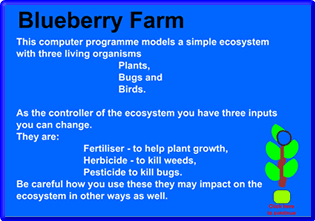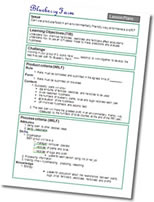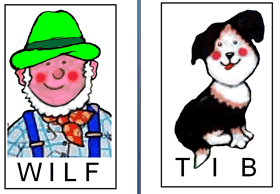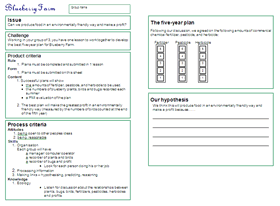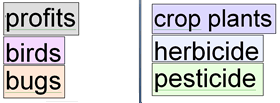

Blueberry Farm is a computer program that models a simple ecosystem

It was designed to be used as part of a sequence of science lessons aiming to help Year 7 pupils understand more about the use of chemical agents in farming and how these can affect ecosystems.
The Year 7 pupils enjoyed using Blueberry Farm and the teachers felt that it served as a valuable tool for stimulating thinking.
Blueberry Farm can be squeezed into one 1 hour lesson, but ideally should be done over two lessons.
Printable copies of the lesson plans are available here.
The activities could be sequenced as follows:
 Lesson 1
Lesson 1
Resources
‘Blueberry Farm’ available for presentation to the whole class - click image on the right to run
Pupil challenge/recording sheets for groups of 3
A model – preferably educational
Raising the issue – aiming for emotional involvement
Raise or refer back to the problem of food production for an ever-increasing population.
The ‘Opinion Corners’ strategy, using a provocative statement like, ‘Farmers should be the ones who decide how food is produced,’ would help pupils to connect to the issue.
Chunking the Challenge – presenting the big picture
Form groups of 3 pupils and give each group a copy of the Blueberry Farm challenge sheet.
If appropriate, explain that you will give time for the pupils to read through the challenge sheet and then you will ask them ‘What do you have to do?’ and they will tell you.
Invite the pupils to monitor their group work with respect to attitudes, skills and knowledge. Bring their attention to the ‘Look for….’ and ’Listen for…’ indicators.
Modelling
Show the first screens of the ’Blueberry Farm’ programme.
Introduce or revisit the idea of computer modelling by examining how we use a physical model e.g. a model of the torso, to understand more about a thing.
In groups -
How is it like / unlike the thing it is modelling?
What are its strengths and limitations? Explain that you will be asking for their views on the strengths and weaknesses of the computer model.
Concept Mapping – aiming to demonstrate/assess current understanding of chemical agents used in farming, the environment and profit.
Refer to the variables on the 'Blueberry Farm' model and use the key words to build a class map of the relationships between them. You may decide to encourage more proficient mappers to build their own group maps to be shared with the class on completion. You may decide to build on the current knowledge.
Hypothesising – aiming to encourage the exploration of ideas through talk.
Having run through the ‘Untended Year’ screens at ‘Blueberry Farm’, demonstrate the selection of the amounts of fertilizer, pesticide and herbicide. Stress the need for careful planning expressed through a well-reasoned hypothesis.
Encourage groups to give each member a chance to say what they think should be the settings and a chance to explain why this would be a good plan.
Groups agree on a plan, and demonstrate understanding in their written hypotheses. These will provide you with another chance to assess the pupils' understanding.
Plenary – aiming to reflect on the learning.
Reflect on the attitudes, skills and knowledge that enabled them to complete the first part of the task.
What did they see/hear to suggest that they were developing good group working skills?
 Lesson 2
Lesson 2
Resources
‘Blueberry Farm’ installed on computers for groups of 3
Pupil challenge/recording sheets for groups of 3
Coloured pencils for recording information.
Connecting – aiming to prepare pupils for the lesson
Completing an unfinished concept map could help pupils prepare for the lesson and provide another opportunity to build understanding.
Recalling the Challenge
Make sure everyone sees the Big Picture and explain that this lesson will give groups the opportunity to test hypotheses.
Modelling Recording
Run the computer program, setting the amounts of fertilizer, pesticide and herbicide, and use A3 copies of the recording sheets to demonstrate how the information can be recorded.
Blueberry Farming – aiming to encourage observation and critical thinking
Use ‘rich’ questioning to encourage observation, description of trends, explanation for trends, prediction of numbers and reflection on the realism of the model.
If time permits, you may allow pupils to benefit from their experience and make a second plan.
PMI evaluation – aiming to encourage reflection and making judgements.
Ask the pupils to do a group evaluation of the experience.
This could focus on one aspect of the work or could take in the plan, the model and the group work.
The ‘Interesting’ section can be a place where pupils record questions that they would like answering.
Plenary – aiming to reflect on the learning.
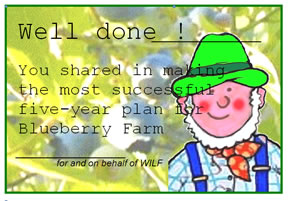 What made for the more successful plans?
What made for the more successful plans?
Is it possible, according to this model, to farm profitably with care for the environmentally?
What are the strengths/weaknesses of the model?
What were the attitudes, skills and knowledge that enabled them to complete the task.
What did they see/hear to suggest that they were developing good group working skills?
How could this be useful in other situations?
Certificates
Having checked that the product and process criteria have been satisfied, you may wish to award certificates to those pupils associated with the most profitable plan, the most environmentally friendly farm (with most birds in year 5), or to all for taking part.
Supporting materials:
Lesson plans
![]() May your berries be many!
May your berries be many!
Blueberry Farm was developed by Richard Taylor, Ian Patience and Joy Tiffin.
Many thanks to the pupils at Seaton Hirst Community Middle School for help trialing the Blueberry Farm activity.
